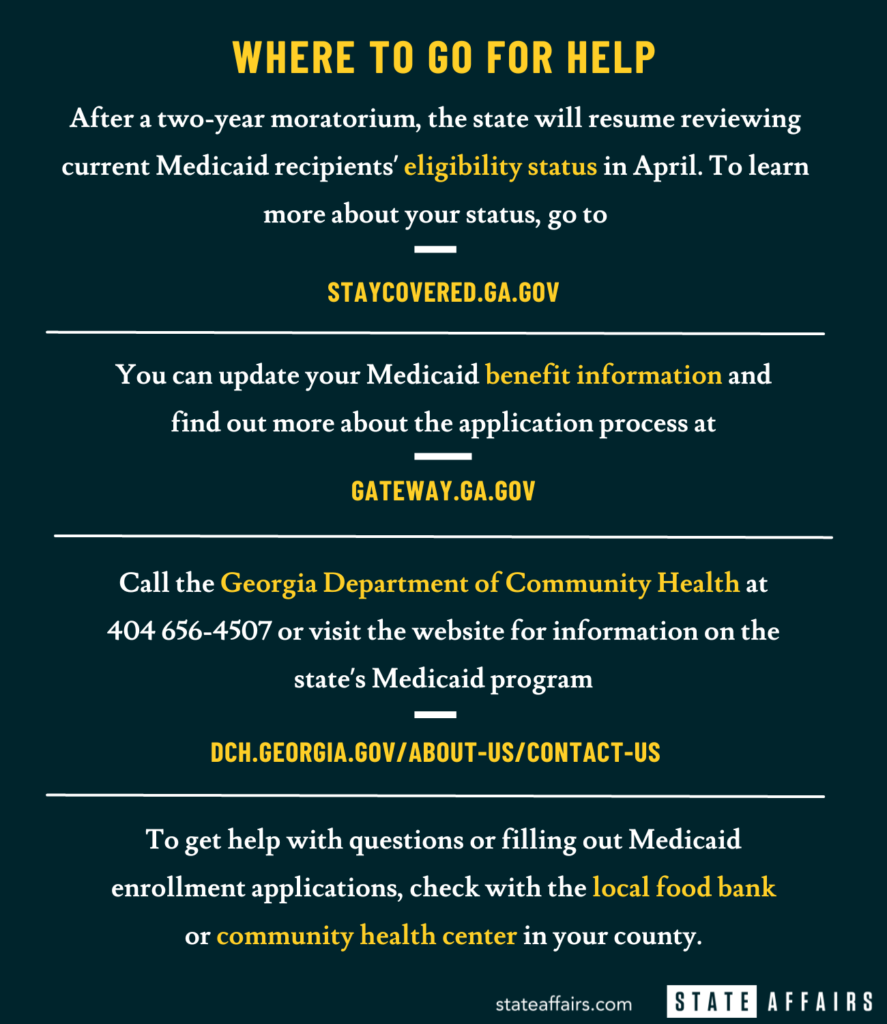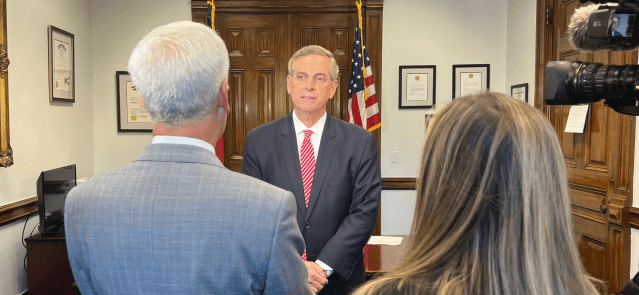Stay ahead of the curve as a political insider with deep policy analysis, daily briefings and policy-shaping tools.
Request a DemoState’s ‘Pathways’ Medicaid program set to begin July 1 amid continued controversy

The Gist
Gov. Brian Kemp is holding firm to his pledge not to expand Medicaid to hundreds of thousands of low-income Georgians. Instead, the second-term governor is touting a work-for-Medicaid plan that will require low-income individuals to complete 80 hours a month of work, school or volunteering to qualify for the benefit.
The plan is unique to the Peach State, and it is not without controversy.
The so-called “Georgia Pathways to Coverage” plan is slated to begin July 1, making Georgia the only state in the country to have work requirements tied to Medicaid coverage.
What’s Happening
Georgia officials have spent more than a decade debating the pros and cons of expanding Medicaid benefits to more Georgians, making it one of the most contentious issues in state politics today, often split along ideological and political party lines.
Georgia currently is one of 12 states that have opted not to extend Medicaid to more low-income people. The expansion plan was introduced in 2010 as part of the federal Affordable Care Act to broaden Medicare health insurance to include previously ineligible Georgians such as adults without children and those making just under the required amount to qualify for the aid.
“Here in Georgia, we’re taking an innovative and sustainable approach,” Kemp said in his annual State of the State address last week. “The Georgia Pathways to Coverage program was negotiated in good faith with the federal government so that we could expand access to health insurance for those who need it the most, while also sustaining the quality of coverage.”
At the start of 2022, Georgia sued the Biden administration, which refused to grant Georgia permission to force a work requirement as a condition to receiving Medicaid, which had previously been approved under former president Donald Trump. After several meetings, public hearings and other discussions, the federal government approved Pathways just before Christmas 2021.
Pathways supporters say the program will better regulate the number of Georgians receiving Medicaid, which in turn will mean better care for patients since the system won’t be overloaded.
“I think it’s in the right direction,” said Steve Brown of Peachtree City who believes most federal money and programs have “strings attached.” Medicaid is funded by a combination of federal and state dollars.
Brown referred to the Pathway program as “a good start.
“And generally [federal funding] means that states are going to end up picking up the tab at some point when the federal government stops paying,” added Brown. “Can the state afford to take on the full burden of whatever they’re offering?”
An estimated 345,000 previously ineligible Georgians are expected to become eligible for Medicaid under the Pathways plan. Some people will pay monthly premiums, which will range from $7 to $16, depending on income and tobacco use.
Critics of Pathway argue that Medicaid is a more commonsense approach to providing health care coverage to hundreds of thousands more Georgians and that it’s more cost-effective than Pathway.
Georgia has spent over $15.3 billion on Medicaid since 2018, Kemp said during his address last week. “… While the state spends more and more, Georgians aren’t seeing an improvement in care they receive.”
Currently, Medicaid is available to Georgians who meet a variety of criteria. If your household income is at or below the current 133% of FPL you’re likely to be eligible for Medicaid. The FPL for 2023 was $14,580 a year for a single person, $19,720 for two people, and $30,000 for a family of four.
An estimated 1.3 million Georgians are uninsured, and Georgia’s uninsured rate of 13.7% is third-highest in the nation. That rate is expected to climb to 1 in 4 uninsured Georgians in rural Georgia by 2026, according to the Georgia Budget and Policy Institute (GBPI).
Medicare vs. Medicaid
Medicare is federal health insurance for anyone over the age of 65. It’s also for some under 65 who may have a disability or condition. A federal agency called the Centers for Medicare & Medicaid Services runs Medicare. Medicare has set standards for costs and coverage which means a person’s Medicare coverage is the same no matter what state they live in. For details, go to medicare.gov.
Medicaid is a joint federal and state program that provides health care insurance to people with limited income and resources. The federal government has general rules that all state Medicaid programs must follow, but each state runs its own program. This means eligibility requirements and benefits can vary from state to state. Medicaid offers benefits that Medicare doesn’t normally cover, like nursing home care and personal care services. People with Medicaid usually don’t pay anything for covered medical expenses but may owe a small co-payment for some items or services. For details, visit medicaid.gov.
Source: HHS.gov
Georgians Remain Divided
Ellenwood resident Pat Pullar is among many troubled by the Pathways to Coverage plan, noting that it “sounds like welfare-to-work.
“Welfare-to-work was for able-bodied people to get a stipend based on their work for the state. I didn’t see that as a problem,” said the retired political consultant. But for Medicaid, “It’s almost like ‘if you don’t work, you’re not going to get health care. It just doesn’t make any sense. We should have some more compassion for people who can’t afford health care,” said Pullar.
“[Georgia’s got] billions of dollars in surplus that you don’t even know what to do with,” said Pullar, referring to nearly $12 billion in Revenue Shortfall Reserve and unreserved, undesignated surplus in state coffers. “But you want people to work for Medicaid.”
Signed into law 58 years ago by President Lyndon B. Johnson to provide health insurance coverage to low-income and disabled Americans, Medicaid has become a contentious and divisive issue in Georgia where lawmakers have repeatedly opted not to bring more Georgians into the program.
Full expansion of Medicaid would bring in more federal dollars that offset costs to the state, some argue.
“It could bring millions in both federal dollars and increased state and local tax revenue, and thousands of new jobs to our state,” Leah Chan, senior health analyst at GBPI told State Affairs. The Pathways program creates “unnecessary barriers,” especially for full-time caregivers and disabled veterans, Chan added.“Fully expanding Medicaid is the best choice for Georgia’s families and the state’s bottom line. The Pathways plan covers fewer Georgians and costs substantially more for the state to implement than a fully expanded Medicaid program,” Chan said.
According to a GBPI analysis of Pathways and Medicaid, the Pathways program would cost about $2,420 per enrollee in the first year compared to about $496 per enrollee under full Medicaid expansion.
Medicaid would enable more people of color, Georgians between the ages of 19 and 34, and those living in rural areas as well as the southern and western parts of the state to get coverage, Chan noted.
But public policy analyst Kyle Wingfield said the Medicaid system is broken and in need of an overhaul.
Wingfield cited the Washington, D.C. think tank Urban Institute’s projections on what a full Medicaid expansion would mean to Georgia if, for instance, it occurred this year.
It would add 739,000 Georgians to the program, cutting the ranks of the uninsured by 448,000.
“This means 291,000 or almost 40% of the potential new enrollees are people who already have insurance,” said Wingfield, president and CEO of the Atlanta-based conservative think tank Georgia Public Policy Foundation. “That’s a key fact that expansion proponents typically overlook and a key reason why expansion would likely cost far more than they allow.”
Wingfield said a Georgia expansion would cost federal taxpayers an additional $3.631 billion and Georgia taxpayers an additional $356 million.
“That means the total first-year cost of expansion would be almost $4 billion — or $8,900 per person who goes from being uninsured to insured,” Wingfield added. “Including those who would simply switch from private insurance to Medicaid, it would be about $5,400. This is a hugely inefficient way to expand a program that already fails to be cost-efficient.”
Medicaid in Georgia: By the Numbers
In July, Georgia will become the only state in America with a work-for-Medicaid program. Here’s a look at the Medicaid environment in Georgia:
- Georgians enrolled in Medicaid:* 2.7 million
- Georgians who are low-income: 32%
- Georgians on Medicaid: 18%
- Georgians who get Medicaid or PeachCare: 1 in 5
- Georgians between the ages of 19 and 64 covered by Medicaid: 1 in 11
- Children with Medicaid coverage: 3 in 8
- Nursing home residents with Medicaid: 5 in 7
- Non-elderly Medicaid recipients who are people of color: 68%
- Adults on Medicaid who are working: 56%
- Births covered by Medicaid: 47%
*Data from Georgians for a Healthy Future.
Source: Georgians for a Healthy Future, Kaiser Family Foundation, October 2022; Georgia Budget & Policy Institute
Why It Matters
In April, the state will begin reviewing who’s eligible — and who’s not — for Medicaid after a nearly three-year moratorium due to the pandemic. That review process will include many, if not most, of the roughly 2.7 million people currently receiving Medicaid in Georgia, according to Laura Colbert, executive director of Georgians for a Healthy Future, an Atlanta-based nonprofit consumer advocacy group.
The process is expected to take a year to complete and comes as the state gets ready to roll out the Pathways program in July. Medicaid eligibility is tied to income/poverty level. In Georgia, a person earning less than $14,580 a year and a family of four earning less than $30,000 a year would be eligible. A Kaiser Family Foundation report looking at Medicaid recipients and work requirements in comparison to welfare-to-work programs found that Medicaid recipients “often face barriers to employment, similar to those experienced by [welfare] enrollees.” Those barriers include physical or mental health disabilities, addiction, limited education, people whose first language isn’t English, and lack of affordable and reliable child care or transportation, the report said.
Most Medicaid recipients Stockbridge resident Emma Davis Hamilton knows aren’t able to work.
“Why is he [Kemp] doing things that are so contradictory to health care and that primarily affects African American and even poor working whites? He’s making it much tougher for poor people,” the retired military officer told State Affairs.
Colbert, of Georgians for a Healthy Future, said Georgia’s current Medicaid system shuts many people who need health care coverage out of the system.
“Georgia has a very stringent Medicaid program,” Colbert noted. “ Our program is one of the least generous programs in the country. The governor has put forth this program for those folks who fall in a coverage gap because Georgia has not expanded Medicaid. For those folks who fall in that gap, this program is going to be very difficult to get in and stay enrolled in.”
Colbert said those folks who fall through the gap generally are Georgians between the ages of 18 and 40; people in rural areas and other places where higher-paying jobs are scarce; workers in low-paying fields such as food service, grocery, retail and childcare; people with mental health and substance abuse conditions; and people of color. Blacks and Latino account for half of the people in Georgia’s Medicaid coverage gap, said Colbert.
What’s Next?
Pathways, the litmus test for how Georgia extends much-needed medical care to residents, is five months away from its debut and will be closely watched.
“I’m eager to see whether the Kemp administration is right, that there’s a better way to administer Medicaid, because Medicaid is a program badly in need of reform,” Wingfield said. “If we’re ever going to reform it, we need to see states trying new things and pioneering better ways to administer the program. If Georgia can be a leader in that, that would be really exciting.”

You can reach Tammy Joyner on Twitter @LVJOYNER or at [email protected]. Joyner is State Affairs’ senior investigative reporter in Georgia. A Georgia transplant, she has lived in the Peach State for nearly 29 years.
Twitter @STATEAFFAIRSGA | @STATEAFFAIRSIN
Facebook @STATEAFFAIRSUS | @STATEAFFAIRSIN
Instagram @STATEAFFAIRSGA | @STATEAFFAIRSIN
LinkedIn @STATEAFFAIRS
Header image: A woman receives a flu shot at a health clinic. (Credit: Brandon Smith for CDC)
Gov. Kemp calls on state agencies to be fiscally restrained amid record $16.5B surplus
The Gist Gov. Brian Kemp asked the state’s 51 government agencies for continued fiscal restraint when drafting their amended fiscal year 2025 and 2026 budgets. Most agencies adhered to his request even as the state’s general fund surplus hit a record $16.5 billion last month. Forty-five agencies, excluding state courts, followed the governor’s instructions to …
Georgia defies bomb threats as election chief declares a “free, fair and fast” vote amid record turnout
ATLANTA – Despite dealing with over 60 bomb threats, Georgia’s election chief said Tuesday the state’s general election went smoothly. Georgia had a record turnout with nearly 5.3 million people voting, Secretary of State Brad Raffensperger told reporters. Election officials in the state’s 159 counties have until 5 p.m. to certify votes. “We had a …
In the (state)house: Meet the newest members of the Georgia legislature
When lawmakers reconvene at the state Capitol on Jan. 13, there’ll be a cadre of new faces in the 236-member Georgia General Assembly, one of the nation’s largest state legislatures. All 236 statehouse seats were up for election this year. Most candidates ran unopposed. Incumbents in contested races easily kept their seats, with the exception …
2 young Democrats win Statehouse seats as Republicans hold majority
ATLANTA — Many Statehouse incumbents appeared to beat back challengers Tuesday, ensuring their return to the Capitol in January. Republicans retain control of the House and Senate. Two Generation Z candidates will join the 236-member Legislature as new members of the House of Representatives: Democrats Bryce Berry and Gabriel Sanchez. Berry, a 22-year-old Atlanta middle …




